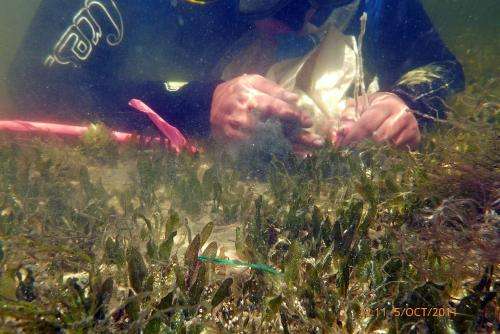New technique helps biologists save the world's threatened seagrass meadows

Danish and Australian biologists have developed a technique to determine if seagrass contain sulfur. If the seagrass contains sulfur, it is an indication that the seabed is stressed and that the water environment is threatened. The technique will help biologists all over the world in their effort to save the world's seagrass meadows.
Seagrass meadows, such as eelgrass or Halophila, grow along most of the world's coasts where they provide important habitats for a wide variety of life forms. However in many places seagrass meadows have been lost or seriously diminished and in their effort to reestablish the meadows biologists can now benefit from a new technique that reveals the health of seagrass.
"It cannot always be seen by the naked eye if a seagrass plant is thriving or not. Therefore, it is necessary to develop methods that reveal the health state of the plant and what causes the failure to thrive. Now we have such a technique", says professor Marianne Holmer from the Department of Biology at the University of Southern Denmark. For many years she has studied the ecology and biogeochemistry of seagrass in temperate and tropical ecosystems.
Seagrass meadows grow along many coasts in the world except where harsh winds, waves and currents are too turbulent for rooted plants to remain attached to the seabed. The meadows are not only a home for a variety of small and large animals; the leaves also help to dampen the waves and the roots help to hold the sediments of the seabed. The plants also act as particle filters that keep the water clear, and they also store carbon and nutrients.
According to Marianne Holmer, biologists today have good knowledge of how light and water quality affect seagrasses, while it is more complicated to understand how sediment conditions affect seagrasses. Together with her colleague Kieryn Kilminster from the Department of Water in Western Australia, she has now developed a technique that can detect whether the sediment conditions are a problem for the seagrasses.
"We take a small piece of plant tissue from a seagrass and bring it back to the lab. Here we analyze it in a so-called mass spectrometer, and this shows us if the plant tissue contains sulfur. If we find sulfur in the plant tissue, it means that the plant has absorbed sulfide from the seabed, and this means that the seabed is not a healthy environment for the seagrass", explains Marianne Holmer.
The sulfide in the seabed is formed by the so-called sulfate-reducing bacteria. They appear, when oxygen disappears from the seabed – this can happen when the seabed is fed large amounts of organic material from algal blooms or from plankton that blooms, when nutrients are released from agricultural farming. The supply of nutrients and particles can also come from cleared coastland. When vegetation is cleared from the coastland, soil and particles are freed and flow into the water. This is a problem in e.g. Australia, where cities are growing rapidly along the coasts.
"A seagrass, which has absorbed sulfide, shows reduced growth and may die-off", explains Marianne Holmer.
When seagrasses absorb nutrients, the nutrients are bound in the plant as it grows. Seagrasses have a relatively long life cycle and nutrients will be bound for a relatively long time compared to being bound in shorter lived seaweed and plankton. If seagrasses are inhibited in growth or disappear from coastlands, bays and fjords, the nutrients become available to other, more short lived plants, and this can lead to increased growth of algae and plankton.
"Many countries are working to restore the lost meadows of seagrasses, and in this work it is important to understand when and why the plants do not thrive. With our new technology, we are now better at this", says Marianne Holmer.
More information: Development of a 'sediment-stress' functional-level indicator for the seagrass Halophila ovalis, Ecological Indicators, Volume 36, January 2014, Pages 280.
Provided by University of Southern Denmark


















